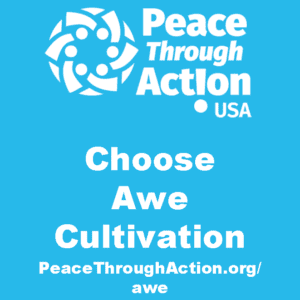What is Awe Cultivation?
Awe is the feeling that one may experience when in the presence of something larger than oneself. Experiencing awe produces salutary effects such as inner calm, the sense of interconnectedness, and the expansion of perspective. There are numerous ways to generate, increase, and reflect upon awe including viewing art, sensing nature, or visiting new places.
While the reason remains unknown as to why awe evolved, it is suggested that awe evolved because it prompted reverence and devotion to powerful leaders and promoted social cohesion. It has also been found that awe helped people identify safe places to seek shelter, such as environments that would have allowed hunter-gatherer to see approaching predators [1]
[1] Darwin, C. (1872). The expression of the emotions in man and animals. London, UK: John Marry, 374.
How do people learn Awe Cultivation?
It is easier to do so than not. Natural scenes are frequent awe elicitors, indicating that stimuli do not need to be physically large to elicit awe. Recalling spiritual and religious experiences, exploring the depths of nature, considering threats to one’s life, as well as the “ultimate awe elicitor” of viewing the Earth from space, can all evoke these feelings of awe. [2]
[2] Allen, S., Ph.D. (2018). The Science of Awe. Executive Summary.
How do people implement Awe Cultivation?
Awe can stem from any stimuli around us, meaning that anyone can find themselves in a place to implement awe. Some people are more frequently “awestruck” than others. There are factors that can possibly explain this difference that include one’s personality, social class, religion, and culture. Those who are more open to new experiences may have a greater tendency to experience awe. On the other hand, people who are less comfortable with ambiguity appear to be less likely to experience the sensation of awe.[3]
[3] Chirico, A., Yaden, D. B., Riva, G., & Gaggioli, A. (2016). The potential of virtual reality for the investigation of awe. Frontiers in Psychology, 7(NOV), 1–6
For what types of circumstances is Awe Cultivation suited?
Awe Cultivation is well suited for developing positive social and emotional behaviors among people who use it.
Does Awe Cultivation work for preventing or controlling aggression or violence?
People experience negative affect, anxiety, and rumination, and engage in a variety of strategies in an attempt to manage the distress that life may bring. Awe is an emotion we feel that requires a perspective shift in order to accommodate the new experience. While working through these distresses, awe increases both well-being and patience, making it a good aspirant for an intervention to reduce the negative effects.[4]
[4] Rudd, M., Vohs, K.D. and Aaker, J. (2012) Awe Expands People’s Perception of Time, Alters Decision Making, and Enhances Well-Being. Psychological Science, 23, 1130-1136.
Where else might I go to learn more about Awe Cultivation?
- Suggestions from the Greater Good Science Center on cultivating awe
- How to go on an Awe Walk
- Why cultivating awe is great for your mental health
Information Sheet-Choose-Awe Cultivation (PDF)
Have a suggested improvement to this information sheet? Send it to inbox@peacethroughaction.org
Do Something Right Away to Increase Peace
Subscribe to our YouTube channel
Give a gift of money to support our mission delivery activities
Choose opportunities to take part in our #PeaceBeginsWithWe campaign

